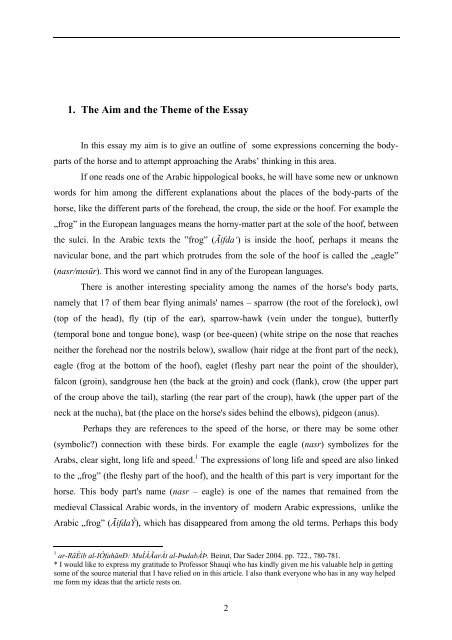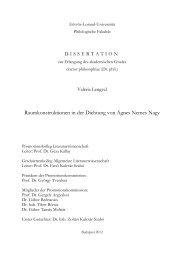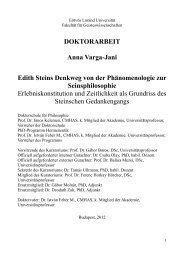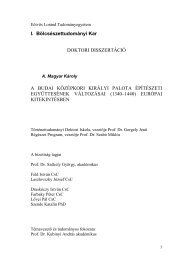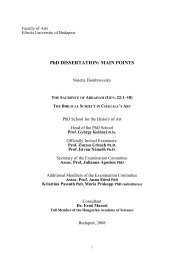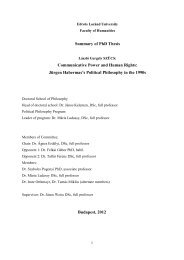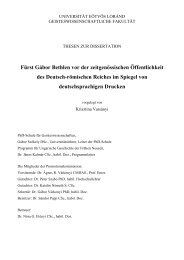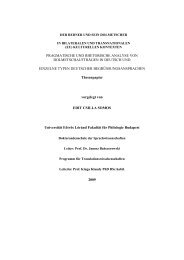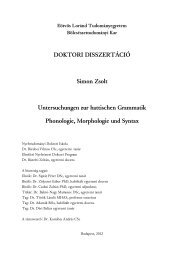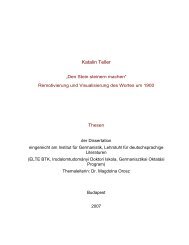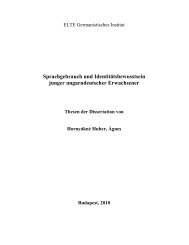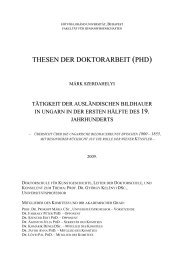Zsuzsanna Kutasi - ELTE BTK disszertációk
Zsuzsanna Kutasi - ELTE BTK disszertációk
Zsuzsanna Kutasi - ELTE BTK disszertációk
You also want an ePaper? Increase the reach of your titles
YUMPU automatically turns print PDFs into web optimized ePapers that Google loves.
1. The Aim and the Theme of the Essay<br />
In this essay my aim is to give an outline of some expressions concerning the bodyparts<br />
of the horse and to attempt approaching the Arabs’ thinking in this area.<br />
If one reads one of the Arabic hippological books, he will have some new or unknown<br />
words for him among the different explanations about the places of the body-parts of the<br />
horse, like the different parts of the forehead, the croup, the side or the hoof. For example the<br />
„frog” in the European languages means the horny-matter part at the sole of the hoof, between<br />
the sulci. In the Arabic texts the ”frog” (Ãifda‘) is inside the hoof, perhaps it means the<br />
navicular bone, and the part which protrudes from the sole of the hoof is called the „eagle”<br />
(nasr/nusūr). This word we cannot find in any of the European languages.<br />
There is another interesting speciality among the names of the horse's body parts,<br />
namely that 17 of them bear flying animals' names – sparrow (the root of the forelock), owl<br />
(top of the head), fly (tip of the ear), sparrow-hawk (vein under the tongue), butterfly<br />
(temporal bone and tongue bone), wasp (or bee-queen) (white stripe on the nose that reaches<br />
neither the forehead nor the nostrils below), swallow (hair ridge at the front part of the neck),<br />
eagle (frog at the bottom of the hoof), eaglet (fleshy part near the point of the shoulder),<br />
falcon (groin), sandgrouse hen (the back at the groin) and cock (flank), crow (the upper part<br />
of the croup above the tail), starling (the rear part of the croup), hawk (the upper part of the<br />
neck at the nucha), bat (the place on the horse's sides behind the elbows), pidgeon (anus).<br />
Perhaps they are references to the speed of the horse, or there may be some other<br />
(symbolic?) connection with these birds. For example the eagle (nasr) symbolizes for the<br />
Arabs, clear sight, long life and speed. 1 The expressions of long life and speed are also linked<br />
to the „frog” (the fleshy part of the hoof), and the health of this part is very important for the<br />
horse. This body part's name (nasr – eagle) is one of the names that remained from the<br />
medieval Classical Arabic words, in the inventory of modern Arabic expressions, unlike the<br />
Arabic „frog” (ÃifdaÝ), which has disappeared from among the old terms. Perhaps this body<br />
1 ar-RāÈib al-IÒfahānÐ: MuÎÁÃarÁt al-ÞudabÁÞ. Beirut, Dar Sader 2004. pp. 722., 780-781.<br />
* I would like to express my gratitude to Professor Shauqi who has kindly given me his valuable help in getting<br />
some of the source material that I have relied on in this article. I also thank everyone who has in any way helped<br />
me form my ideas that the article rests on.<br />
2


